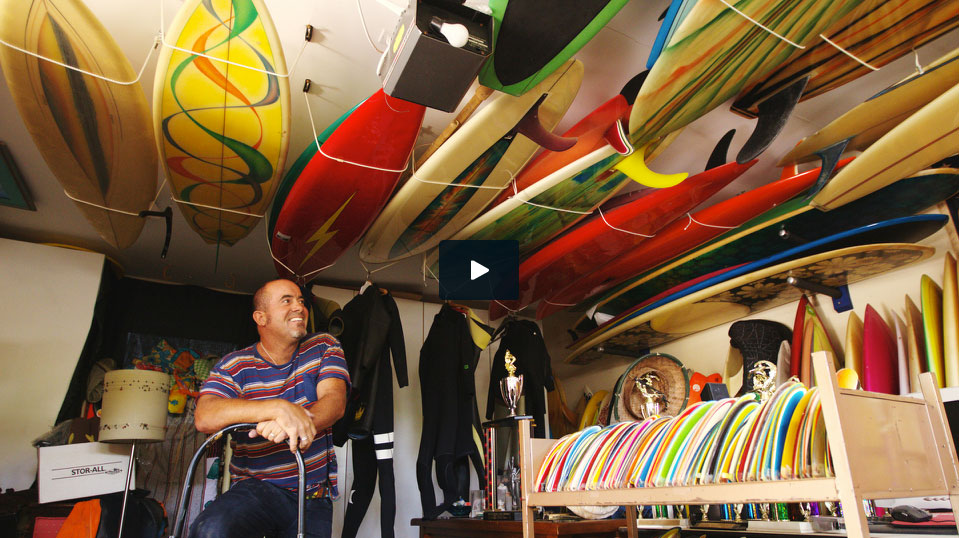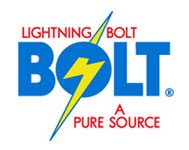Catri
Pick a surfing stereotype from smuggler to savior and you’ll find a piece of Dick Catri. Widely considered “the godfather of East Coast surfing,” this Floridian has influenced the sport for more than 40 years. Competing, coaching, repping, retailing, shaping — some would even say, shystering — Catri never missed an opportunity to promote the surfing lifestyle at home and abroad, crossing paths with renowned watermen from the venerable Duke Kahanamoku to modern wonder Kelly Slater.
Born in New Jersey, Catri [pronounced CAH-tri] moved to Miami as a boy. Upon graduating from high school in 1957, he began working as a beach attendant where he met a stunt diver named Jack “Murph the Surf” Murphy, who later achieved infamy for stealing the Star of India, the world’s largest sapphire. The California native introduced Catri to surfing in the winter of 1957, and together they experimented with building boards and took surfing adventures through Florida and California. While Murphy and Catri’s escapades were far from pure, they never reached the level of grand larceny that Murphy did with his jewelry heist in 1964. By that time, Catri had already spent three seasons in Hawaii and was on his way to becoming a North Shore fixture, surfing everywhere from Pipe and Waimea to Makaha and working at Dick Brewer’s factory.
In the spring of 1964, Catri went back to Florida to quench the East Coast’s thirst for surfing. As the East Coast rep for Dick Brewer’s Surfboards Hawaii, Catri opened a shop in Satellite Beach and established a team of greats that included Gary Propper, Mike Tabeling, Bruce Valuzzi, Fletcher Sharpe and Mimi Munro, who soon ruled surfing contests along the Atlantic Seaboard. When Hobie made him a generous offer in 1966, the team switched labels and continued trouncing the competition. Catri was not only captain and coach for the Hobie squad; he remained a competitor and attended several U.S. championships. He was also inducted into the 1966 International Hall of Fame, represented the United States at the 1968 World Contest in Puerto Rico and surfed in the 1967 Duke Kahanamoku Invitational. His personal life was also winning during this period. He married his second wife, Shagg, and named a store after her in Indialantic. Though they later divorced, the couple had three daughters and Shagg’s Surf Shop still remains in its original location.
The rise of the shortboard movement in the late ’60s transformed Catri from a seller of West Coast brands to an East Coast manufacturer. After parting ways with Hobie, he started Catri Surfboards and became Clark Foam’s first East Coast distributor. More importantly, the ’70s marked Catri’s benchmark days as a contest promoter. Besides running the annual Easter Surfing Classic event he founded in 1965 with John Griffin (now a 36-year tradition known as the Cocoa Beach Easter Surfing Festival), the partners established the Sundek Classic and a new association, American Professional Surfing (APS). Over five years, the APS grew to become a 14-event tour with its own world tour stop, the $25,000 Florida Pro. It churned out East Coast talent like Matt Kechele and Charlie Kuhn before being eclipsed by the ASP in the early ’80s.
Soured by the experience, Catri once again focused his attention on coaching local amateurs, helping produce another crew of East Coast heroes, including WCT pro Todd Holland, Florida standouts Scott Bouchard, David Speir and Sean Slater, as well as Slater’s 7-year-old brother, Kelly. If it sounds like Catri’s direct influence stayed concentrated near Sebastian Inlet, it did, and rightfully so. Catri was one of the first to surf Sebastian, and when conflicts between fishermen and surfers resulted in a blackball ordinance, he successfully helped fight the law until it was repealed in the early ’70s. This preserved First Peak for future generations to fight over.
Catri’s life wasn’t all self-sacrifice. He regretfully admits to “borrowing” a couple of boards with Murphy on their first trip to California. He was also convicted of marijuana smuggling in the ’70s; a low point he offers as example to those struggling with the lure of easy, illicit cash. Fortunately, popular opinion would forgive such flaws, and he was inducted into the East Coast Surfing Legends Hall of Fame in 1996.
Today, Dick Catri enjoys a semi-retired lifestyle with his wife Terri just miles from Sebastian. When not organizing the annual Easter Festival, Captain Catri stays near the water by running fishing charters and, like every respected godfather, speaks his mind about surfing, especially when it comes to his East Coast territory. — Matt Walker, August 2000
KEY: O= Original, R= Repaired, RF= Refurbished. Condition of board rated: 1(worst)-10(best)
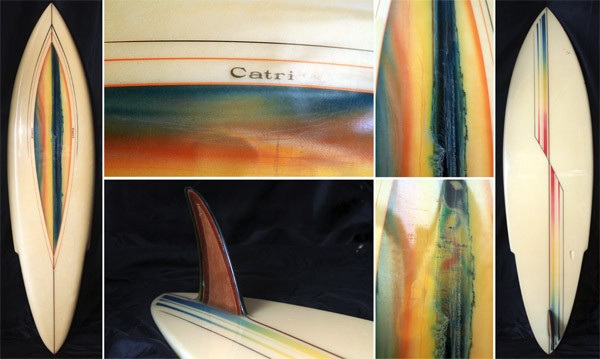 |
| Length: 6’5 “ | Width: 19 5/8″ | Thickness: 2 7/8″ | Condition: (O) 9 |
| Got this board in a multi-board hoarding purchase from the East Coast. Beautiful Wave Scape Air Brush, all original, 1977 Sting Pintail. Perfect Board with the exception of one surface ding that happen in transit. But great example of Catri and his passion of surfing art and the Sunshine State. |
| Click below for a detailed image: |
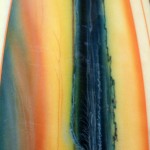 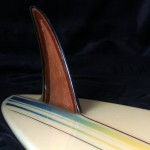 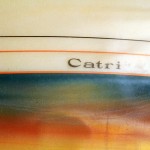 |
 Union >>
Union >> -
Jim Phillips
At first glance, no doubt, but a Glenn Branch air brush on the above board


